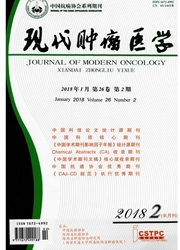

 中文摘要:
中文摘要:
目的:应用抑制性消减杂交(SSH)技术构建XTP6反式激活相关基因差异表达的cDNA文库,筛选XTP6蛋白反式激活相关基因。方法:构建XTP6真核表达载体pcDNA3.1(-)-XTP6,并将其转染HepG2细胞,以空载体pcDNA3.1(-)为对照;48h后收获细胞后提取mRNA并逆转录成cDNA,tester cDNA经RsaⅠ酶切消化后分成两组,分别与两种不同接头衔接,再与过量的driver cDNA进行两次消减杂交及两次抑制性PCR反应,第二次PCR产物与pGEM—Teasy克隆载体连接,构建cDNA消减文库,转化大肠杆菌进行文库扩增,随机挑选克隆经PCR鉴定后进行测序及同源性分析。结果:成功构建人XTP6蛋白反式激活相关基因差异表达的cDNA文库。扩增后得到70个200—1000bp插入片段的克隆,随机挑选其中20个插入片段测序,并通过生物信息学分析获得其全长基因序列,结果共获得11种已知功能编码基因。结论:筛选到的cDNA全长序列,包括一些与细胞周期调节、生物代谢和炎症修复密切相关的蛋白编码基因。
 英文摘要:
英文摘要:
Objective:To screen and identify human genes trausactivated by XTP6 by constructing a cDNA sub-tractive library with suppression subtractive hybridization (SSH) technique. Methods: Suppression subtractive hybridization and bioinformatics techniques were used for screening and cloning of the target genes transactivated by XTP6 protein. The mRNA was isolated from HepG2 cells transfected pcDNA3.1 ( - ) - XTP6 and pcDNA3.1 ( - ) empty vector, and SSH method was employed to analyze the differentially expressed DNA sequence between the two groups. After restriction enzyme Rsa Ⅰ digestion, small sizes cDNAs were obtained. Then tester cDNA was divided into two groups and ligated to the specific adaptor 1 and adaptor 2, respectively. After tester cDNA was hybridized with driver cDNA twice and underwent two times of nested PCR , the second PCR production was subcloned into pGEM - Teasy plasmid vectors to set up the subtractive library. Amplification of the library was transformed into E. coli. The cDNA was sequenced and analyzed in GenBank with Blastn search after PCR. Results: The subtractive library of genes transactivated by XTP6 was constructed successfully. The amplified library contains 70 positive clones containing 200 - 1000 bp inserts. Sequence analysis was performed in 20 clones randomly, and the full length sequences were obtained with bioinformatics method. Altogether 11 coding sequences were gotten. Conclusion:The obtained sequences may be target genes transactivated by XTP6, and some genes coding proteins involved in cell cycle regulation, biological metabolism and inflammation repair.
 同期刊论文项目
同期刊论文项目
 同项目期刊论文
同项目期刊论文
 期刊信息
期刊信息
